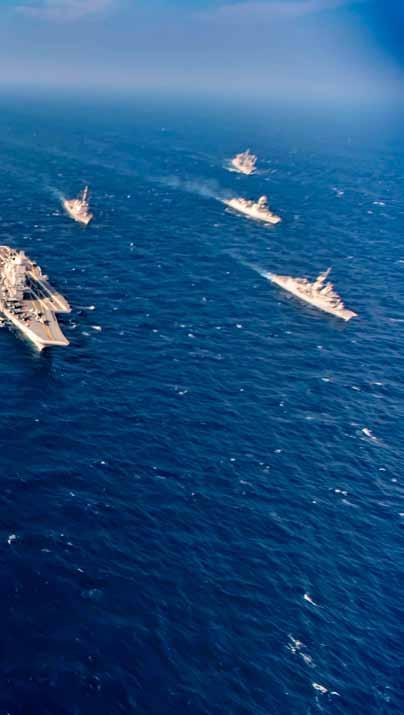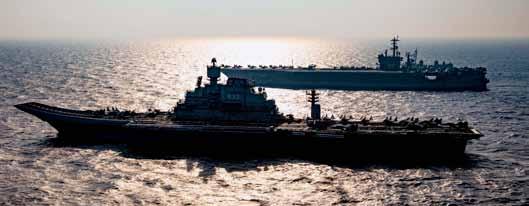
3 minute read
Malabar Exercise: Checking the Chinese ambitions
The 24th edition of the two-phased Malabar exercises, which ended on Nov. 20, had a special significance as the Australian Navy participated in it for the first time since 2007. Moreover, this was the first time that all the four Quad or Quadrilateral Coalition members came together to show off their naval strength. And indeed it was a real show of strength that must have made some nations with overweening territorial ambitions in the region like China sit down and think.
The Quad was conceived at an August 2007 meeting in Manila, held on the sidelines of ASEAN Regional Forum, between the prime ministers of India, Japan, and Australia and the vice president of the United States. The following month using the already existing Malabar exercise framework, established when they first began in 1992 between the Indian and US navies, a major naval drill was conducted between the navies of India, US, Japan, and Australia, with Singapore participating as well. China responded angrily and issued formal diplomatic protests. A nervous Australia quickly backtracked from the Quad and made its intention clear to not participate in future Malabar exercises. Quad 1.0 was in limbo. The US India, and Japan eventually began to exercise trilaterally and Australia was not in the picture until this year
Advertisement
There was speculation earlier that the possibility of angering China had prevented India from expanding the Malabar Exercise with Australia joining it. But in recent times, the importance of Australian participation was realised. This importance was evident in the words of Defence Minister Rajnath Singh.
On October 27, following the Indo-US 2+2 dialogue, he said: “We agreed that upholding the rulesbased international order, respecting the rule of law and freedom of navigation in the international seas and upholding the territorial integrity and sovereignty of all states are essential. Our defence cooperation is intended to further these objectives. Both sides welcomed Australia joining the forthcoming
Malabar Exercise.”
Rear Admiral Sudarshan Shrikhande, who retired in 2016 and earlier headed naval intelligence, said that “with the clearer enunciation of the Quad at the recent foreign ministers’ meet in Japan, it would have been counterproductive to the objectives of statecraft not to invite Australia.” Shrikande , a former defence advisor at the Indian High Commission in Canberra (2005-08), said the Quad “must, among other things, contribute to being a key instrument of deterrence that is necessary keeping China in mind”.
Phase-1 of Malabar Exercises, held off Visakhapatnam in the Bay of Bengal between Nov.3-6, witnessed the participation of Indian Navy units with USS John S McCain (a guidedmissile destroyer), Australia’s Ship HMAS Ballarat along range frigate with an integral MH-60 helicopter, and Japan’s JMSDF Onami, a destroyer with an integral SH-60 helicopter. Complex and advanced naval exercises including surface, antisubmarine and anti-air warfare operations, cross deck flying, seamanship and weapon firing exercises were witnessed in Phase 1. Numerous other maneouvres were also conducted.
The Indian Navy was led by Rear Admiral Sanjay Vatsayan, Flag Officer Commanding Eastern Fleet in the Phase I exercises. Indian Navy ships, including the destroyer Ranvijay, the frigate Shivalik, off shore patrol vessel Sukanya, fleet support ship Shakti and submarine Sindhuraj, took part In addition, the advanced jet trainer Hawk, the long-range maritime patrol aircraft P-8I, the Dornier maritime patrol aircraft, and helicopters participated in the exercises.
Phase 2 was conducted in the Arabian Sea between Nov Nov.17-20. The joint operations centered around the Vikramaditya carrier battle group of the Indian Navy and Nimitz carrier strike group of the US Navy. The two carriers, along with other ships, submarine and aircraft of the participating navies, were engaged in high intensity naval operations over four days. The exercises included cross-deck flying operations and advanced air defence exercises by MIG 29K fighters of Vikramaditya and F-18 fighters and E2C Hawkeye of Nimitz. Accompanying Nimitz was the cruiser Princeton and destroyer Sterett in addition to P8A maritime reconnaissance aircraft.
In addition to Vikramaditya and its fighter and helicopter air-wings, the Indian side had indigenous destroyers Kolkata and Chennai, stealth frigate Talwar, Fleet Support Ship Deepak and integral helicopters also participated. They were led by Rear Admiral Krishna Swaminathan, Flag Officer Commanding Western Fleet. The indigenously built submarine Khanderi and P8I maritime reconnaissance aircraft of the Indian Navy also showcased their capabilities.
The ‘non-contact, at sea only’ exercises, conducted in view of COVID-19 pandemic, showcased the high-levels of synergy and coordination between the four navies, based on their shared values and commitment to an open, inclusive rules-based international order. It is this commitment alone that will make China wary of playing mischief in the region.












